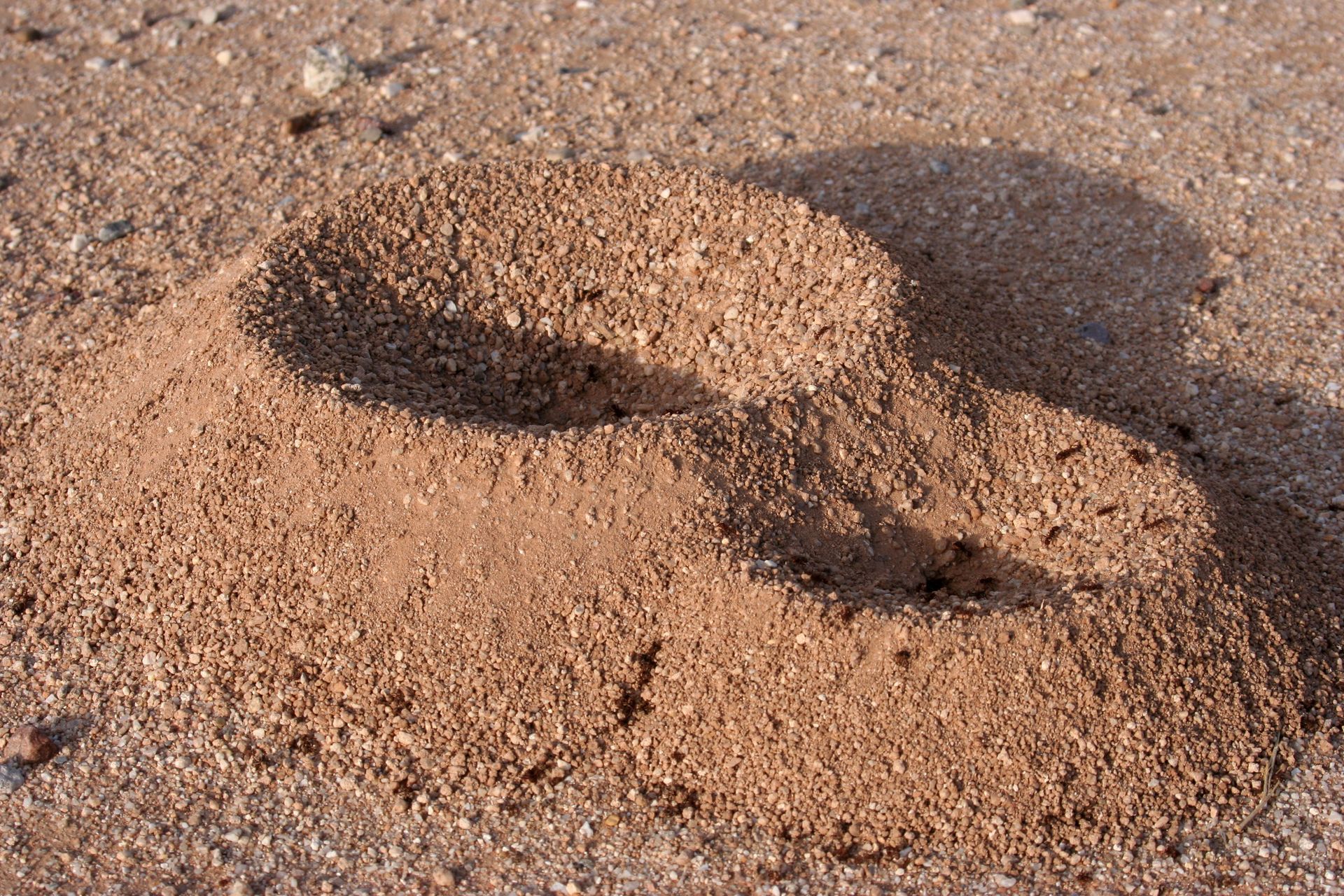Common Types of North American Beetles Around Your Home
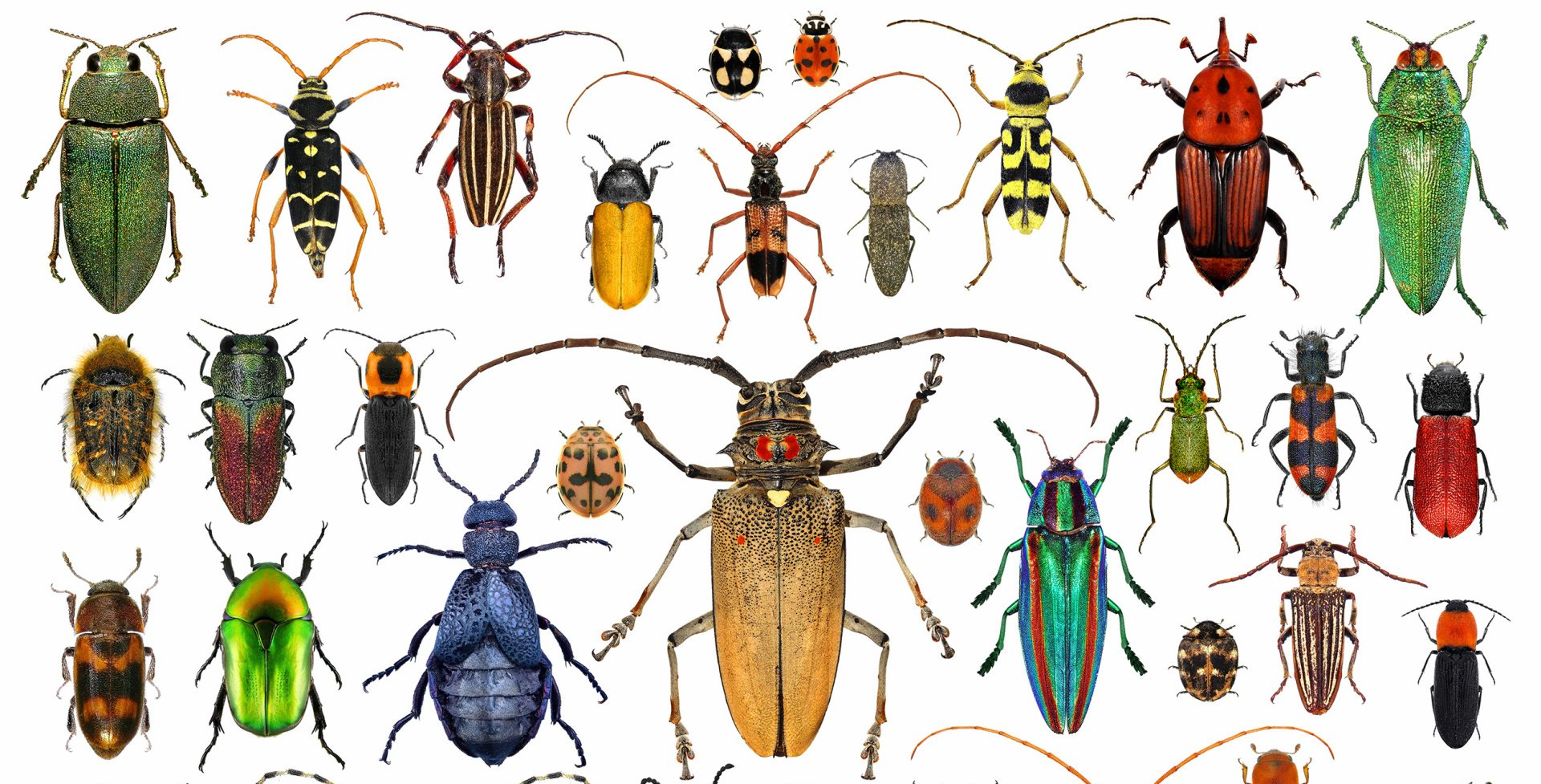
Beetles are in the order of Coleoptera, and they make up the largest group of insects found around the world. There are approximately 350,000 - 450,000 species and they are said to account for 25% of the animals that live on this planet as well as 40% of the insect world. In North America, it is estimated that over 30,000 different species exist with 10 of the biggest beetle families accounting for roughly 70% of all beetles found north of Mexico. The wide variety of species have developed to live in every habitat around the world with the exception of the harshest and coldest environments that are often not habitable for insect life.
Identification Chart of Different North American Beetle Types
| Beetle | Family | Size | Diet | Identified By |
|---|---|---|---|---|
| Ladybug | Coccinelidae | .8 - 18 mm | Aphids & soft bodied insects | Red shell with black dots |
| Weevils | Curculionoidea | 6 mm | Grains, crops, & plants | Mixed colors with an enlongated snout |
| Scarabs | Scarabaeidae | 1.5 - 160 mm | Insects, carrion, fruit, & fungi | Vary in color and size |
| Dung Beetles | Scarabaeidae | 5 - 30 mm | Feces & decaying organic matter | Black, brown, or green outer shell |
| June Beetles | Scarabaeidae | 12 - 25 mm | Grains, crops, & plants | Reddish brown to black shell |
| Japanese Beetles | Scarabaeidae | 15 mm | Crops & plants | Metallic green thorax with copper wings |
| Hercules Beetles | Scarabaeidae | 50 - 85 mm | Fruit | Dark heads and bodies with large hornlike pincers |
| Grapevine Beetles | Scarabaeidae | 1.7 - 3 cm | Fruit (primarily grapes) | Yellow to orange bodies with small black dots |
| Figeater Beetles | Scarabaeidae | 3.2 cm | Fruit (primarily figs) | Semi-glossy green shell with bright green legs |
| Ground Beetles | Carabidae | 1 - 66 mm | Insects & invertebrates | Vary in color and size |
| Tiger Beetles | Carabidae | 10 - 20 mm | Insects & invertebrates | Long legs, bulging eyes, and large mandibles |
| Bombardier Beetles | Carabidae | <2.5 cm | Insects & invertebrates | Bluish wings with red head and legs |
| Fiery Searcher Beetles | Carabidae | 25 - 35 mm | Insects & invertebrates | Bright metallic green wings with gold grooves |
| Leaf Beetles | Chrysomelidae | 1 - 35 mm | Crops & plants | Vary in color and size |
| Potato Beetles | Chrysomelidae | 6 - 11 mm | Crops & plants (primarily potatoes) | Squat oval bodies with orange heads and striped wings |
| Striped Cucumber Beetles | Chrysomelidae | 8 - 13 mm | Crops & plants (primarily cucumbers) | Enlongated yellow bodies with black stripes or spots |
| Skin Beetle | Dermestidae | 10 - 25 mm | Dead animal or plant matter | Black, brown, or mottled shell |
| Carpet Beetle | Dermestidae | 3 - 5 mm | Dead animal or plant matter | Black, brown, or mottled shell |
| Jewel Beetles | Buprestidae | 3 - 80 mm | Trees, plants, flowers, and grasses | Bright iridescent green, blue, or purple colors |
| Emerald Ash Borer Beetles | Buprestidae | 10 - 20 mm | Insects & invertebrates | Long legs, bulging eyes, and large mandibles |
| Long Horned Beetles | Cerambycidae | 2 mm - 6 cm | Trees | Shiny black shell with lighter markings & long antennae |
| Sawyer Beetles | Cerambycidae | Bright metallic green wings with a purple body | Insects & invertebrates | Bluish wings with red head and legs |
| Carrion Beetle | Silphidae | 9 - 30 mm | Decaying organic matter | Black shell with orange spotting |
| Rove Beetles | Staphylinidae | 1 - 35 mm | Plants, insects, fungi, organic matter | Dark with short wings & 6-7 abdominal segments |
| Scarlet Lily Beetles | Chrysomelidae | 6 - 8 mm | Lily flowers, leaves, & stems | Bright red bodies with black legs and head |
| Drugstore Beetles | Ptinidae | 2.25 - 3.5 mm | Grains, dried goods, plants | Brown to reddish brown shell |
| Stag Beetles | Lucanidae | 5 - 12 cm | Fruit & sap | Dark outer shell with extremely large mandibles |
| Soldier Beetles | Cantharidae | 1.5 - 28 mm | Pollen & nectar | Enlongated orange bodies with black head and markings |
| Blister Beetles | Meloidae | 2.5 cm | Pollen & nectar | Enlongated bodies with soft wings and long antennae |
Information About North American Beetles
Ladybugs
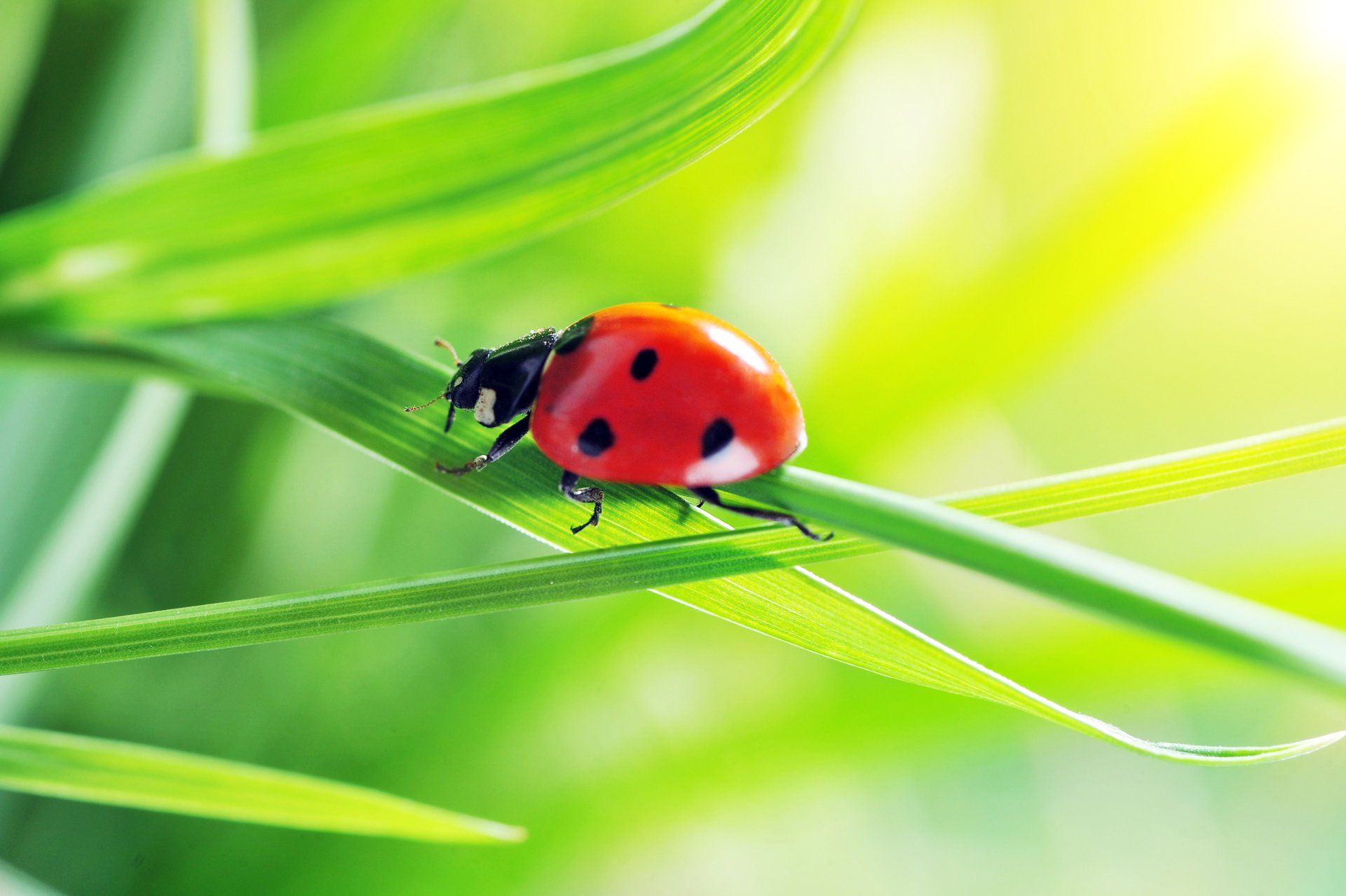
Ladybugs are a common small beetle that are typically between .8 – 18mm long and acts as a beneficial predator in household gardens. They are omnivorous and feed on aphids, beetle larvae, and other soft bodied plant eating bugs as well as leaves and fungus. Ladybugs will lay their eggs near aphid colonies, so they have ample food sources to feed on while they develop. They are found around the world in North America, Asia, and Europe with more than 450 species found in North America. The most common variety in identified with a bright red shell with black dots but there are several other species that also come in black, orange, yellow, and brown. Even though most species of lady bugs are beneficial, there are some that can potentially cause damage to crop like the squash beetle and Mexican been beetle.
Weevils
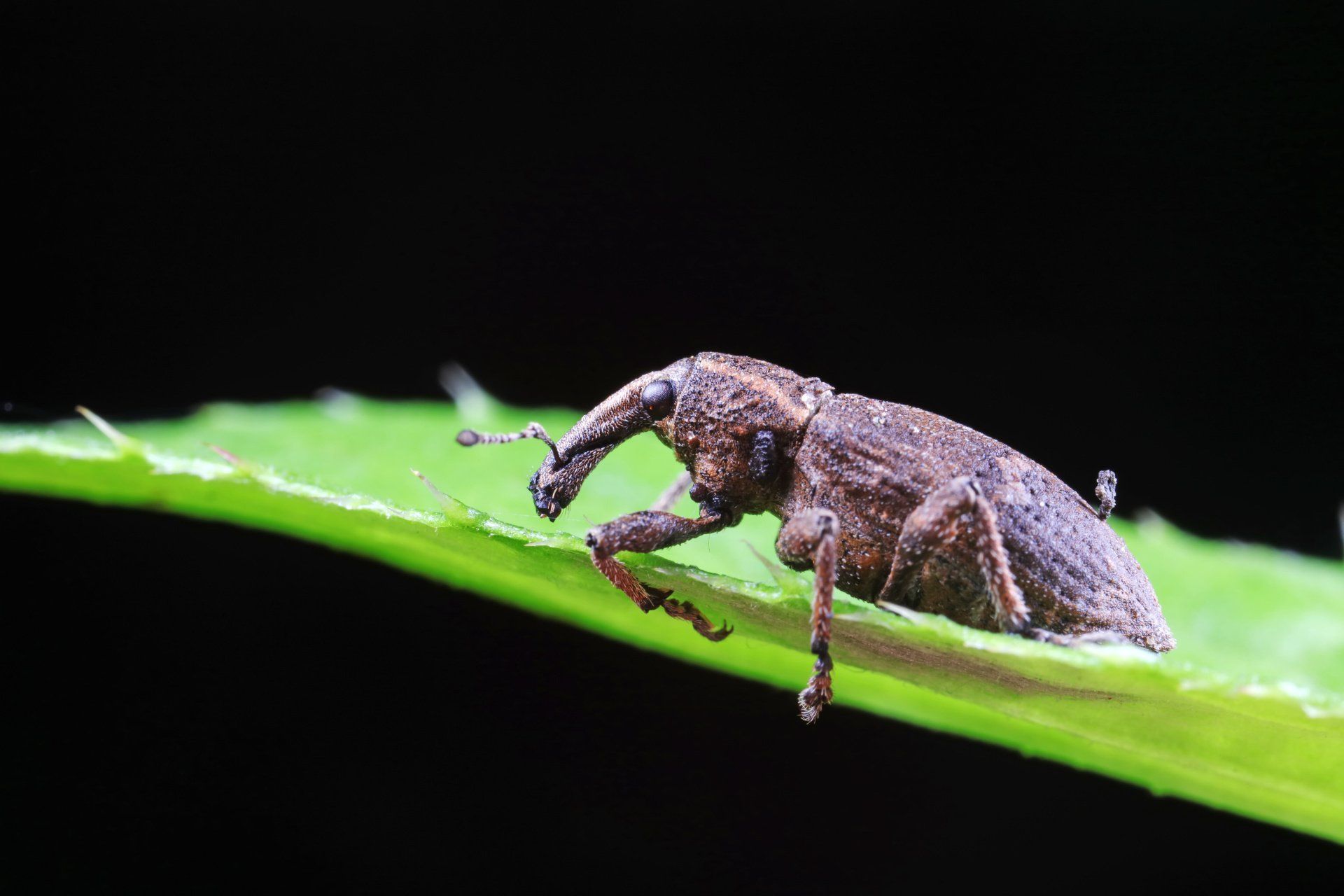
Weevils are generally about 6mm long and are commonly identified by their large snouts. They are usually brown, black, or green with a slender oval body type. Weevils are the most common beetle type with close to 100,000 different species with 2,500 species living in the US and Canada. Unlike other beetles that may be somewhat beneficial, weevils are one of the most destructive beetles and are often the cause of extensive crop damage and contamination of stored grains. This is why they are a common household pantry pest which can destroy a home’s supply of grains, cereals, and oats in addition to devastating a garden.
Scarabs
Scarabs make up a large group of beetles with over 30,000 species spanning the globe with approximately 1,400 species that exist in the US. Scarabs are most commonly known for being depicted in movies filmed about ancient Egypt because they represent the incarnation of the Egyptian sun god, Ra. They can range from 1.5 – 160 mm due to the extreme sizes of some of the species that make up this class of beetle. They are mostly shiny and sometimes metallic in appearance with oval bodies. They have unique antennae that help detect smells and pheromones and rugged front legs that are designed to help dig out their habitat to protect themselves from predators. Scarabs typically feed on carrion, feces, and decaying plant matter and some species can be damaging garden pests that can devastate plants and other crops.
Dung Beetles
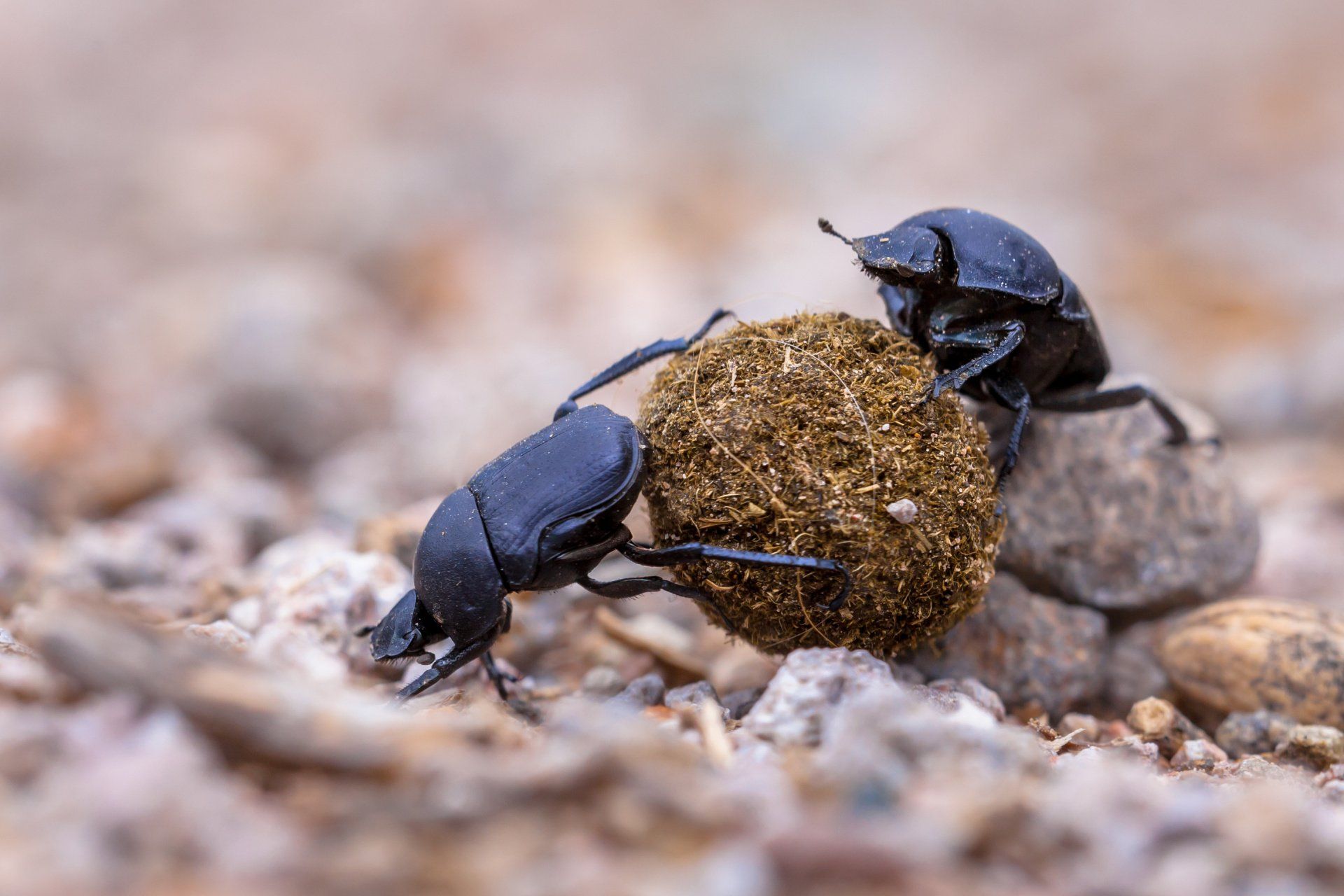
Dung beetles are found all over the planet and range in size from 5 – 30 mm long. They only eat feces and can be found burrowing in the excrement of different animals. They are typically brown or black with some species having more bright metallic exoskeletons.
June Beetles

June beetles are a common scarab beetle that is found all over the eastern US and Canada. They are identified by their reddish brown to black wings and body. They are decent sized and can grow up to 12 -25 mm long and are often found swarming around bright lights. They are somewhat destructive and can cause damage to the unharvested fruits they feed on.
Japanese Beetles

Japanese beetles are a common scarab that is native to Japan but has become an invasive species in North America. They are potentially one of the most destructive beetles found in the US, causing damage to over 300 different species of garden plants and wildlife. Adults consume the flowers and the leaves of the plants while the larvae consume the roots causing a plant to die off quickly if these beetles are not kept under control. They can grow up to 15 mm long are identified by shiny copper-colored wings and green body and head. They fly extremely well which allows them to infest a large area in a small time.
Hercules Beetles
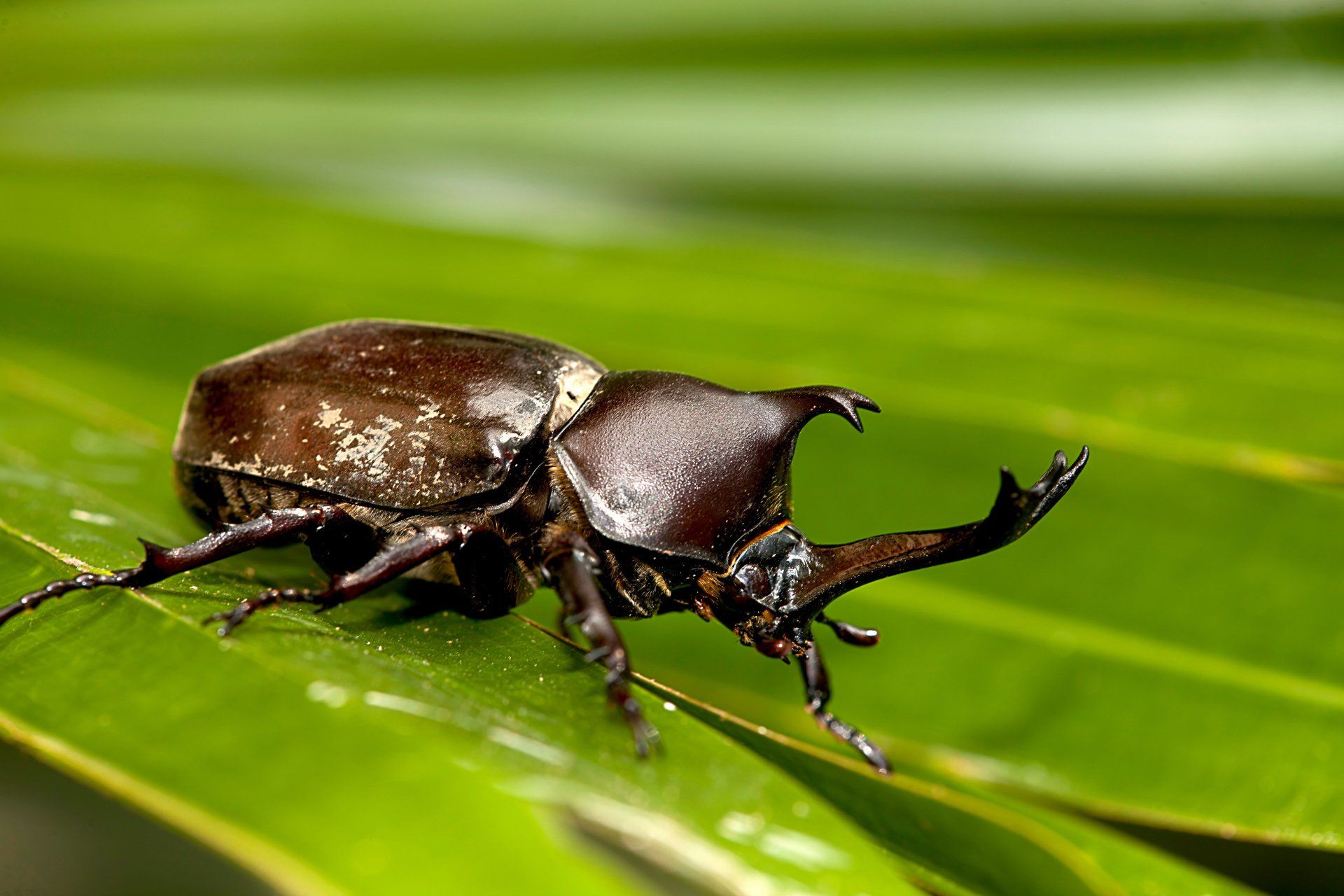
This very large type of beetle is found all over the Americas and are some of the largest beetles in the world. They can grow up to 50 - 85 mm long and males have a large protruding horn that emerges from their heads which is why they are also often called rhinoceros beetles. This horn is designed to help defeat other males who are competing for female attention when it comes time to mate. They are also identified by hard wing covers that can come in different colors from brown, green, grey, and black combined with a dark head and hornlike pincers that move vertically. Despite its threatening look and imposing size, Hercules beetles are herbivores and are harmless to humans.
Grapevine Beetles
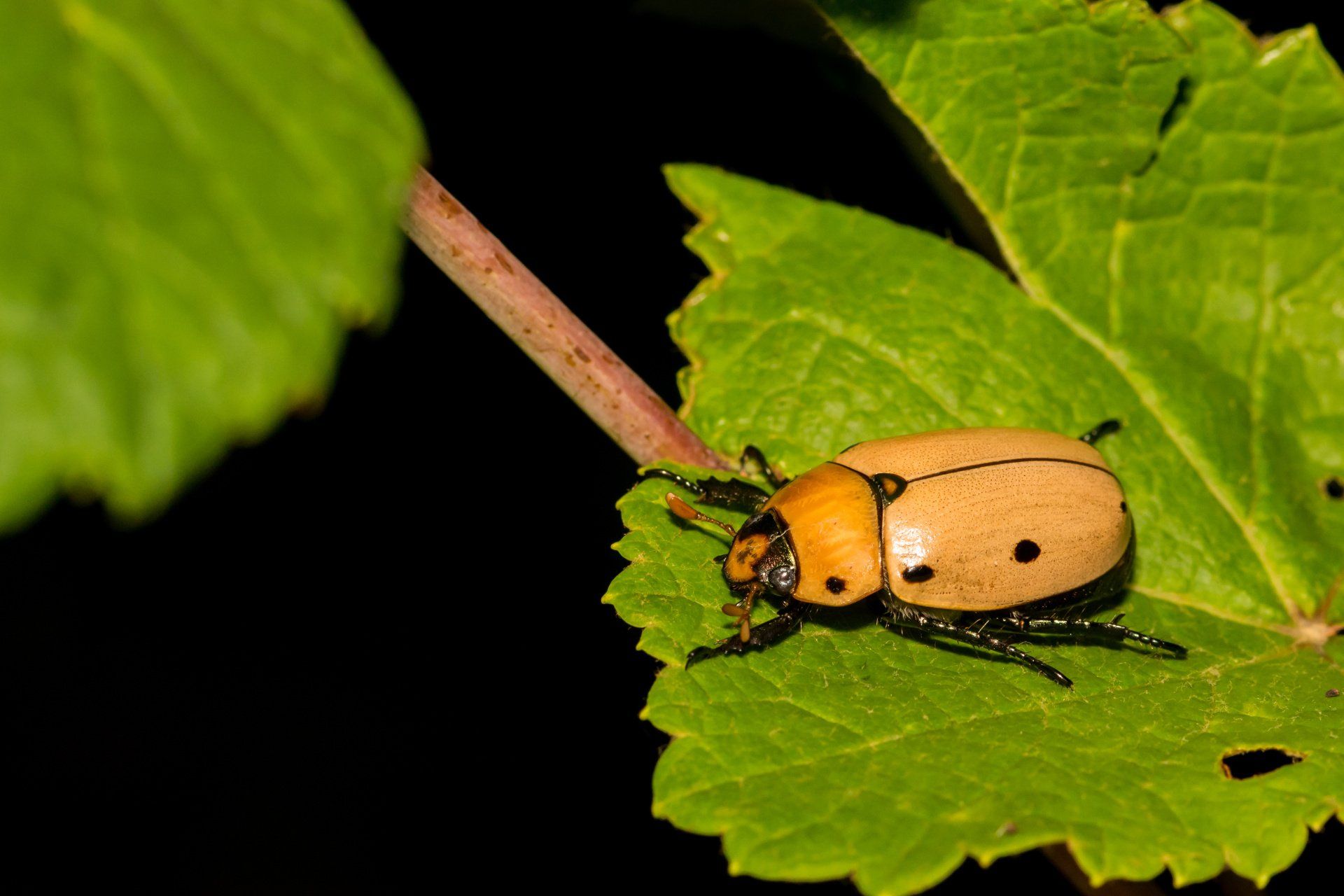
The grapevine beetle is another scarab beetle that can grow up to 1.7 – 3 cm and is identified by its bright orange or auburn shell will black dots or lines. It is a fast flyer that feeds of grapevine leaves but isn’t classified as destructive pest since the damage it does in minimal.
Figeater Beetles
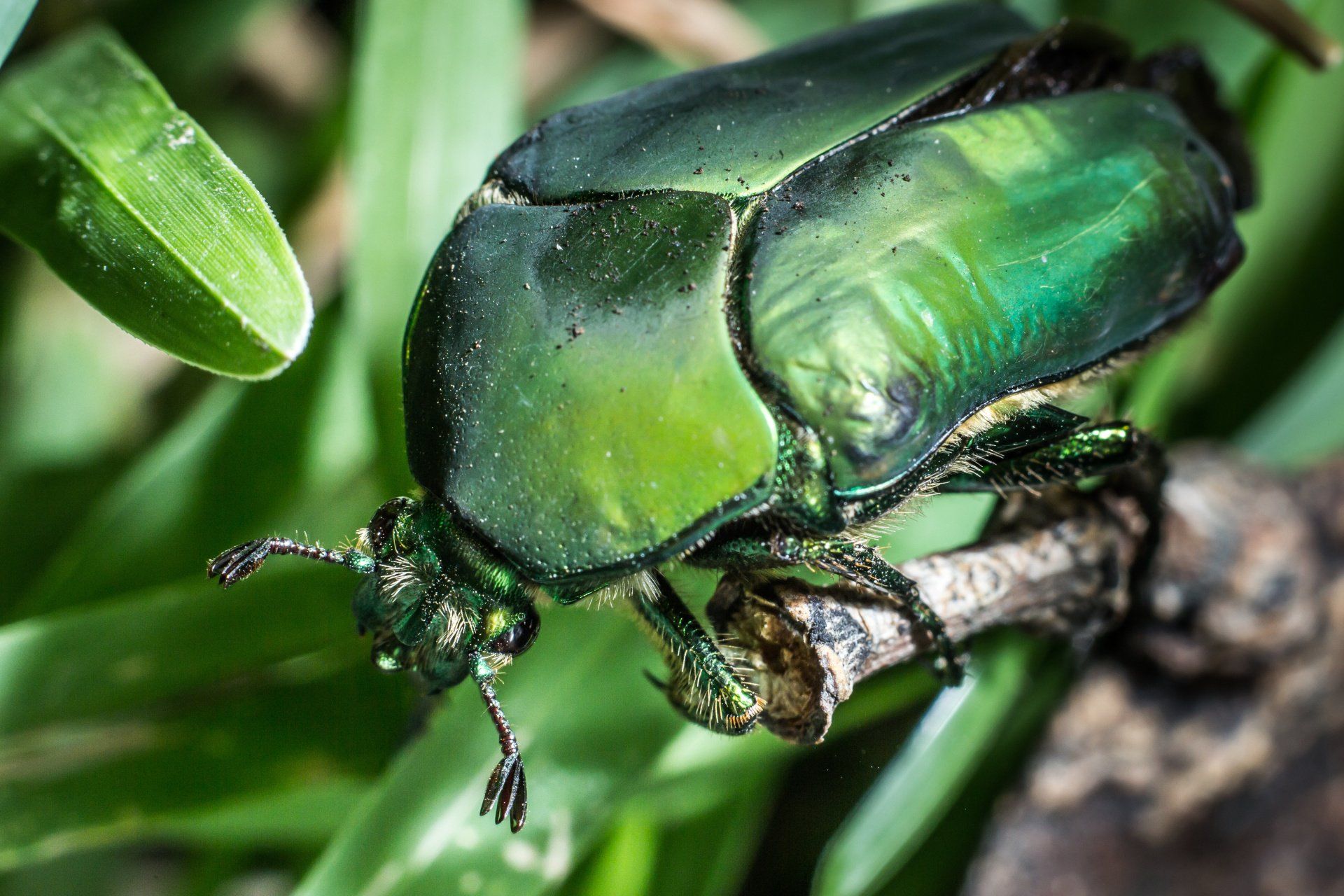
Figeater beetles grow typically up to 3.2 cm long and are identified by their large shiny green bodies and bright orange sides. They are often confused for June beetles, but they are slightly larger and are more commonly found in the Southwestern US where June beetles are more common in eastern states. They are mostly found searching for decaying food by flying around in people’s yards, mulch, and compost piles.
Ground Beetles
Ground beetles have over 40,000 species around the world with roughly 2,000 in North America. They are typically 1 – 66 mm long and come in a variety of different colors with the most common being a shiny or metallic black shell. They are commonly mistaken for cockroaches but unlike cockroaches since they are found at ground level under rocks, leaves, and other debris. They have ridged wing covers and can create violent excretions that they use as a defense mechanism. They are also hunters that feed on a variety of other insects including ants, snails, slugs, and worms. 2 common species of ground beetles found in North America are tiger beetles and bombardier beetles.
Tiger Beetles
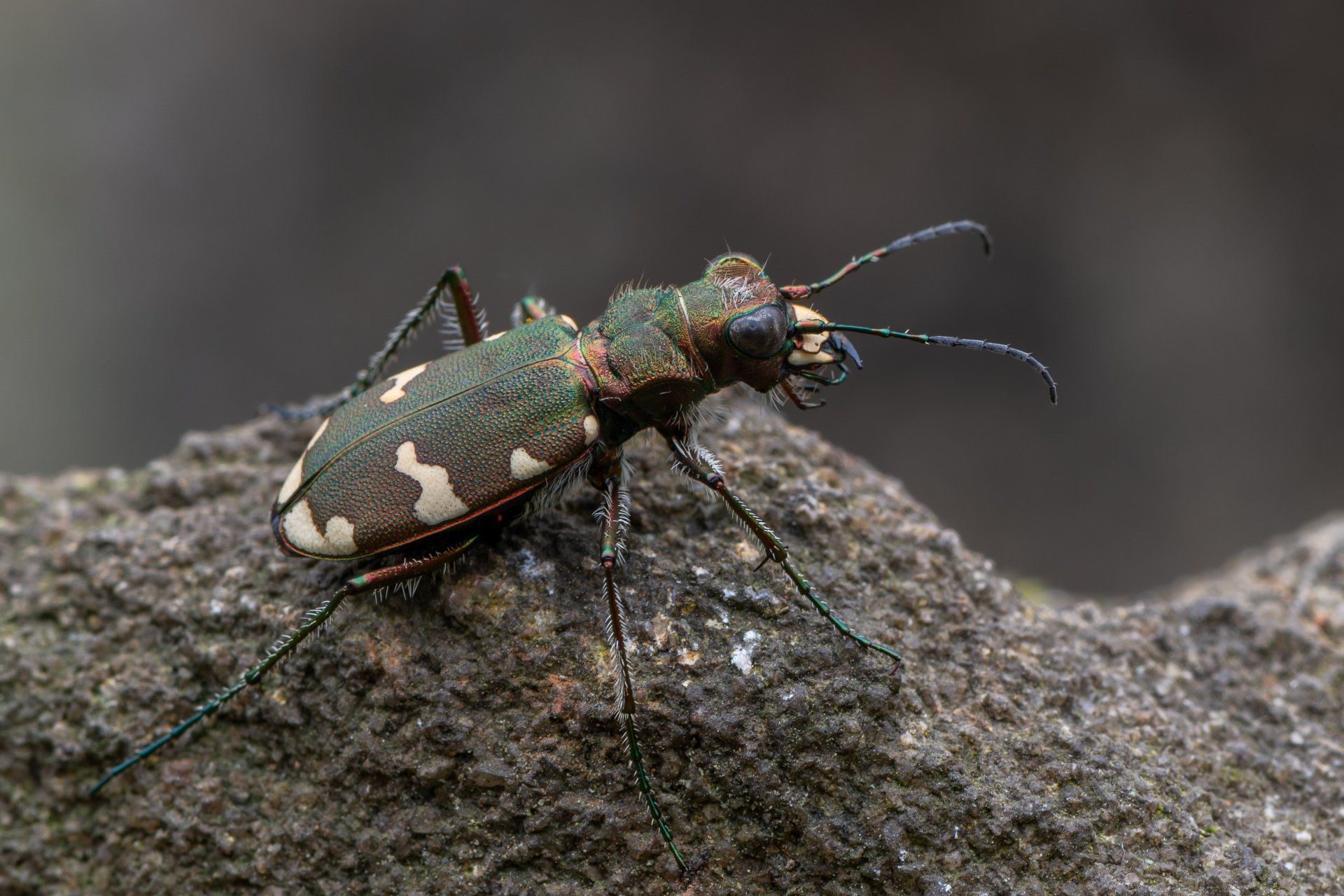
Tiger beetles are just one of thousands of different species of ground beetles. Within this classification, there are roughly 2,600 species of tiger beetles which are identified by their metallic shells and long curved jaws. The other impressive feature of tiger beetles is that they can reach speeds of 5.5 mph when they hunt for their prey. They are about 10 - 20mm long and can take out insects smaller than them to feed on.
Bombardier Beetles
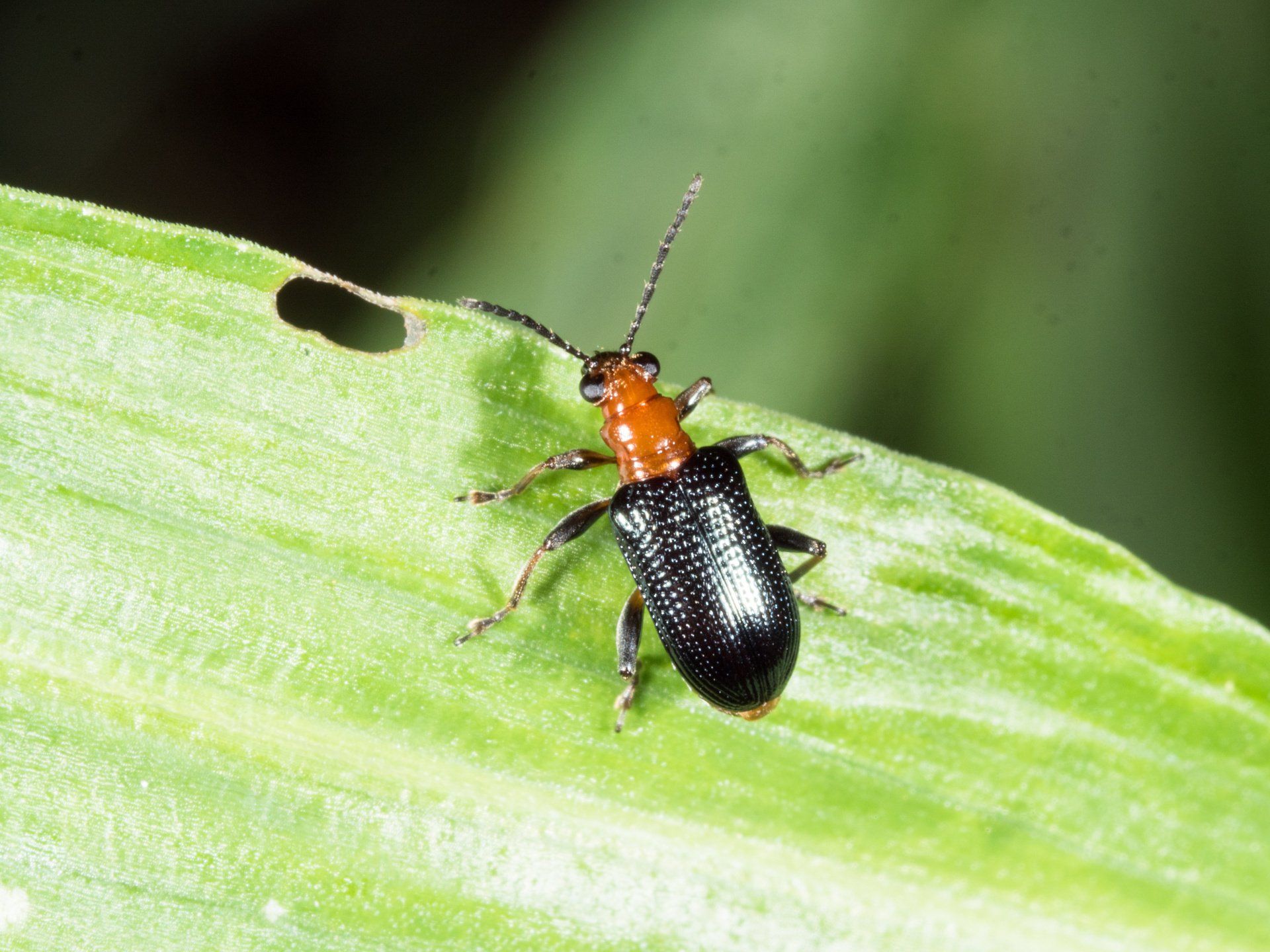
Bombardier beetles are a type of ground beetle known for some extremely unique characteristics. They have a chamber within their body where they can mix 2 separate caustic chemicals to a boiling point before shooting it out of their tail towards a potential threat or prey. This mixture can kill smaller insects they feed upon and even burn human skin. These beetles are typically under 2.5 cm and black and red. They can be found throughout the world hiding in places like under rocks and leaves.
Fiery Searcher Beetles
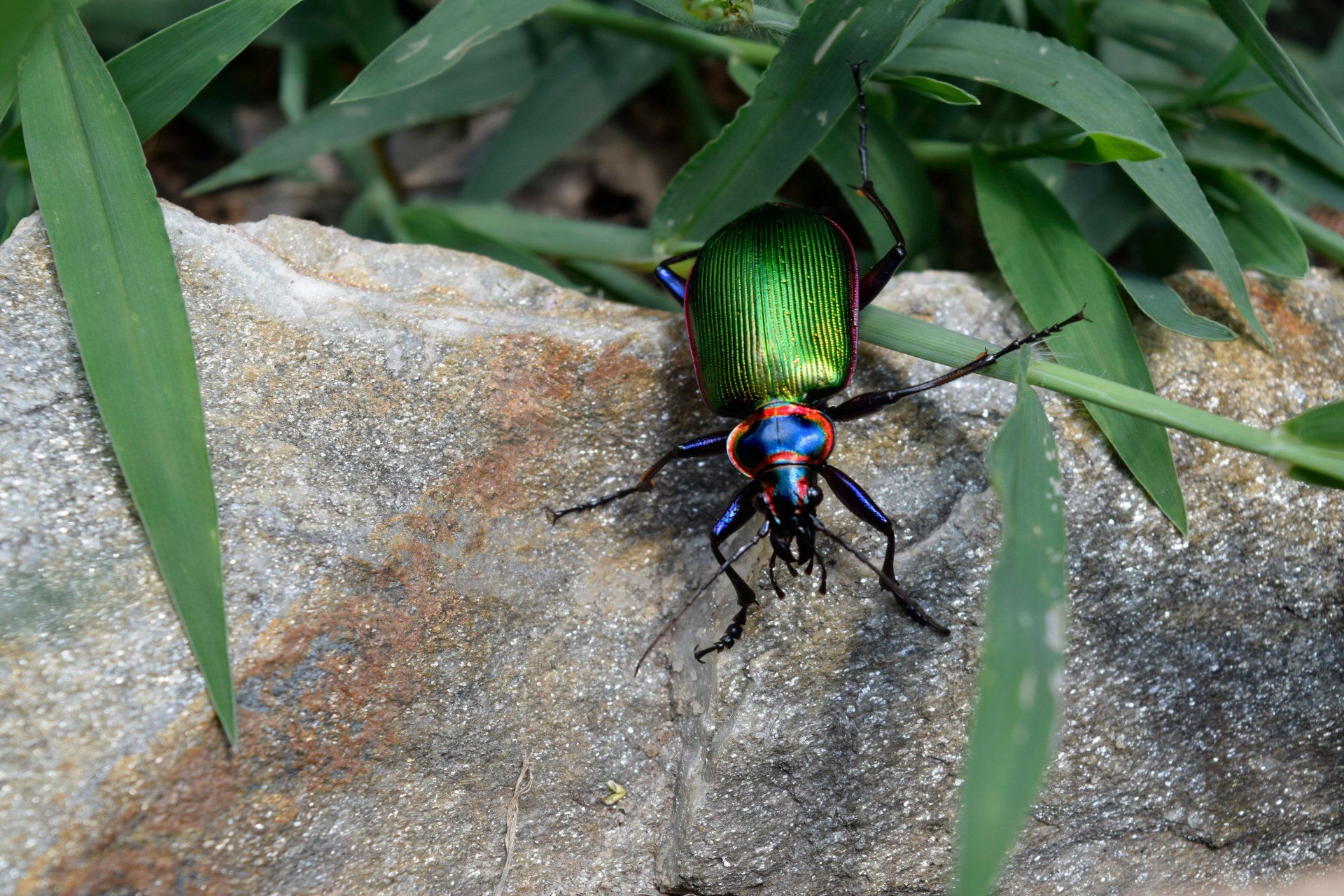
Fiery searcher beetles are a species of ground beetle known for hunting caterpillars. They can reach lengths of 25 - 35 mm long and are identified by metallic green wings and a shiny blue body and head. They are excellent nocturnal hunters who feed on damaging pests. They use an interesting defense mechanism in which they squirt an oil that smells rancid like rotten milk.
Leaf Beetles
Leaf beetles are another common type of beetle that have over 37,000 species worldwide and 2,000 species in North America. They can grow between 1 – 35 mm and the color and shape of the different species vary wildly. These beetles earn their name because they are herbivores that feed primarily on the leaves of plants around their habitats. Even though they prefer to feed on the leaves, leaf beetles will also consume the stems, flowers, pollen, shoots, seeds, and roots of plants as well. In large enough numbers, leaf beetles can devastate local plants and bushes because they have voracious appetites. These beetles might be slow, but they have a strong defense mechanism where they produce poisonous chemicals from their mouths. This deters them from being eaten by predators.
Potato Beetles

Potato bugs are beetles that are found in the US and Mexico. They grow to be between 6 – 11 mm and are identified by their bright orange or yellow wings with 10 black stripes. These beetles are damaging to crops because they feed on garden variety plants in the nightshade family like tomatoes, potatoes, eggplant, and peppers.
Striped Cucumber Beetles
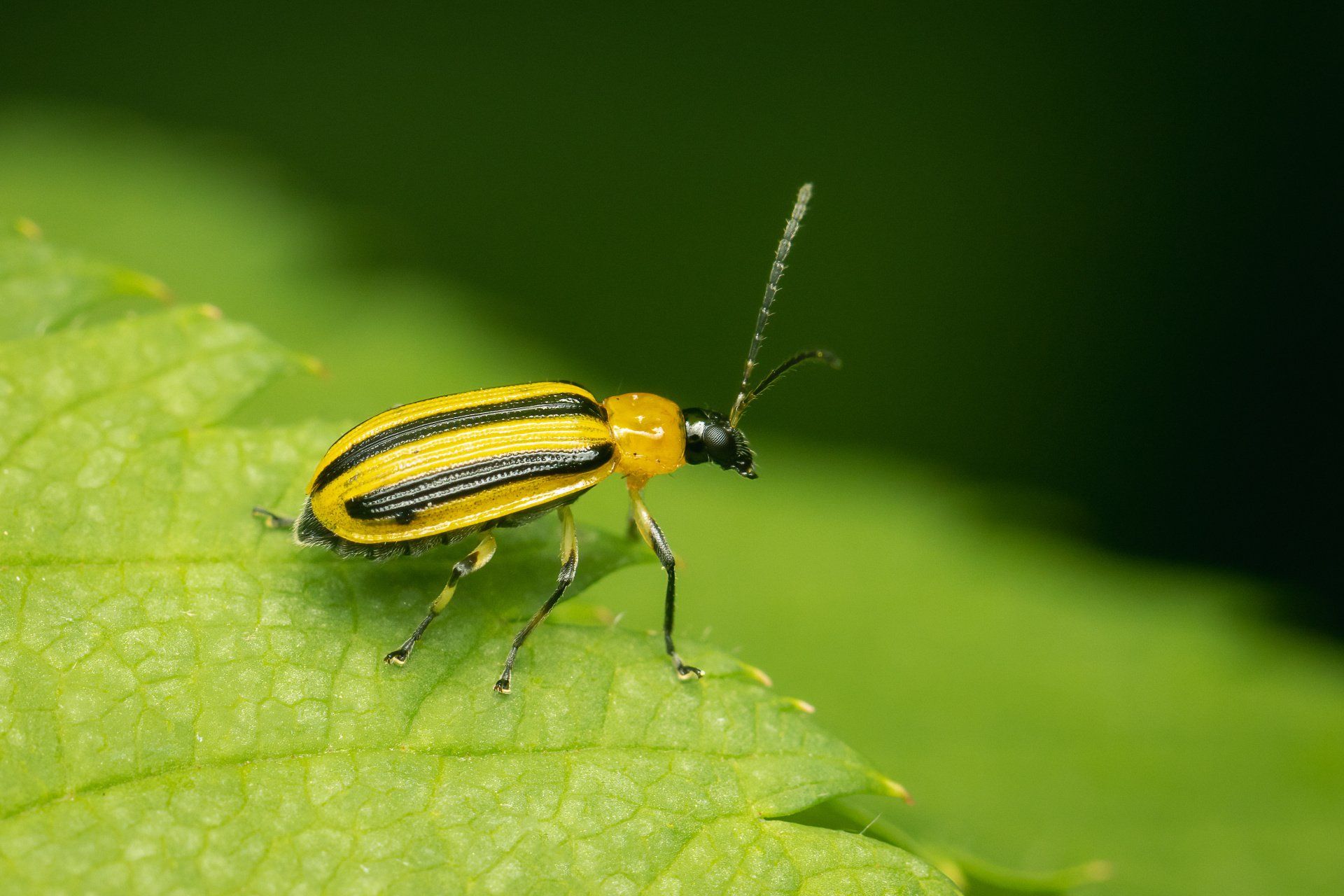
The striped cucumber beetle is a small beetle that grows between 8 - 13 mm long and is identified by its bright yellow body with black stripes. This is another garden pest that can devastate plants like cucumbers, melons, and pumpkins. They attack these plants in 2 ways, with the adults feeding on the leaves and flowers while the grubs consume the roots and shoots of a plant. If left unchecked, these beetles will devastate a garden quickly by leaving plants without foliage or introducing plant pathogens that weaken and eventually kill off a plant.
Skin Beetles
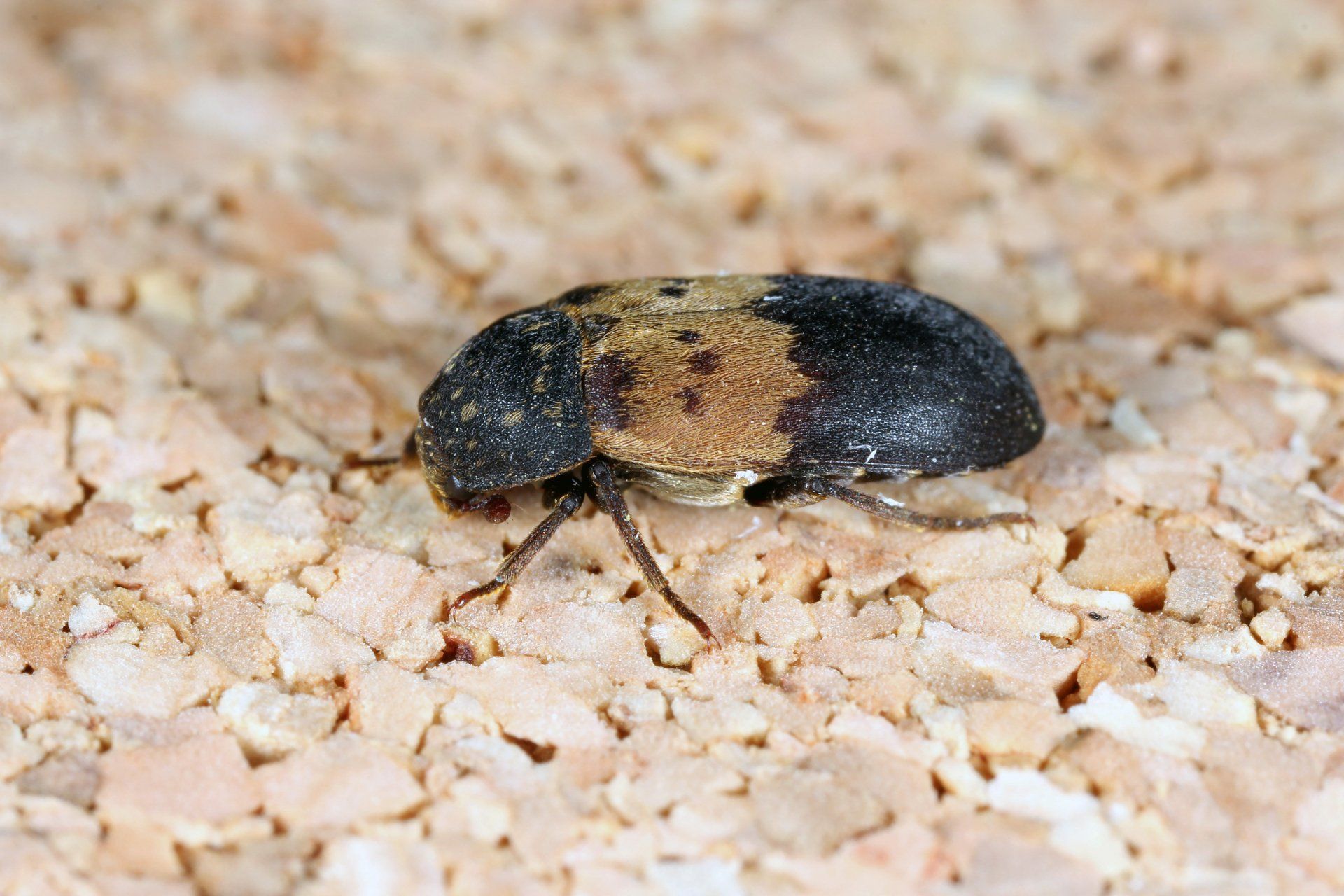
Skin beetles, also known as flesh eating beetles and taxidermy beetles, are used to help clean bones. They feed on decomposing organic matter and have the unique ability to digest keratin which is found in human hair, skin, and nails. They have long bodies between 10 - 25 mm and come in colors ranging from black, brown, and red.
Carpet Beetles

Carpet beetles start out with larvae that are covered in large bristles which feed on carpeting, wool, linens, clothing, and even dead and dried out organic matter. While many people think that it is the adult beetle that feeds on these materials, it is only the larvae that causes this damage. The problem is that the larval stage can last for up to 3 years in some species of carpet beetles. There are roughly 200 species of carpet beetles with the most common species in North America is identified by a black and long oval shell that measures between 3 – 5 mm.
Jewel Beetles
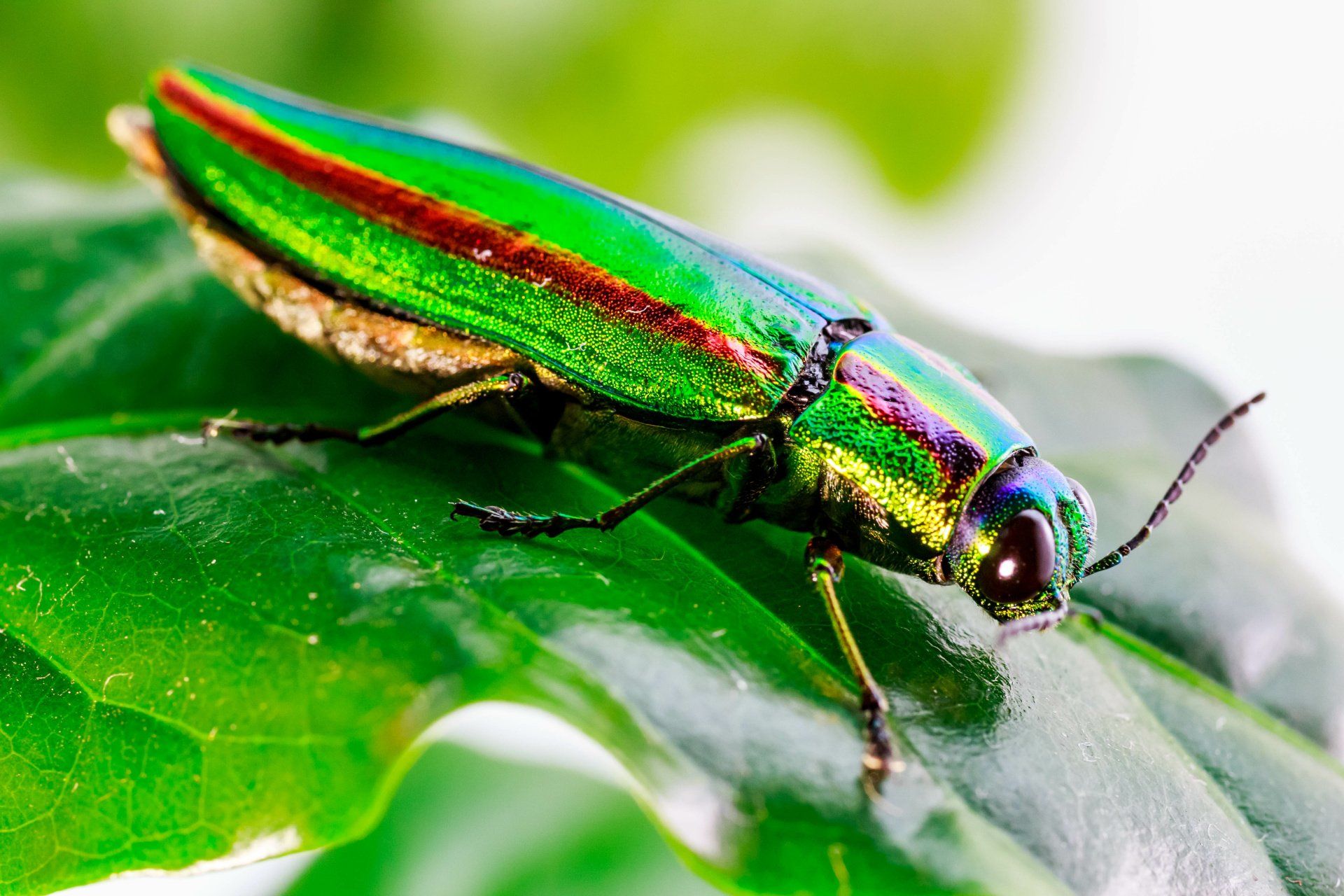
Jewel beetles are a shiny wood boring beetle that has a similar shape to a bullet. Their bodies vary in size and can grow between 3 – 80 mm. They are often a metallic green, blue, purple, copper, or black which is where they get their name. These beetles and their larvae are extremely destructive as wood borers causing significant damages to trees. Unlike other wood boring organisms that prefer dying, decaying, or dead trees to feed on, jewel beetles will attack live trees causing enough damage to kill the tree off. There are over 700 species that exist in North America, with the most famous and damaging species being the invasive emerald ash borer beetle.
Emerald Ash Borer Beetles
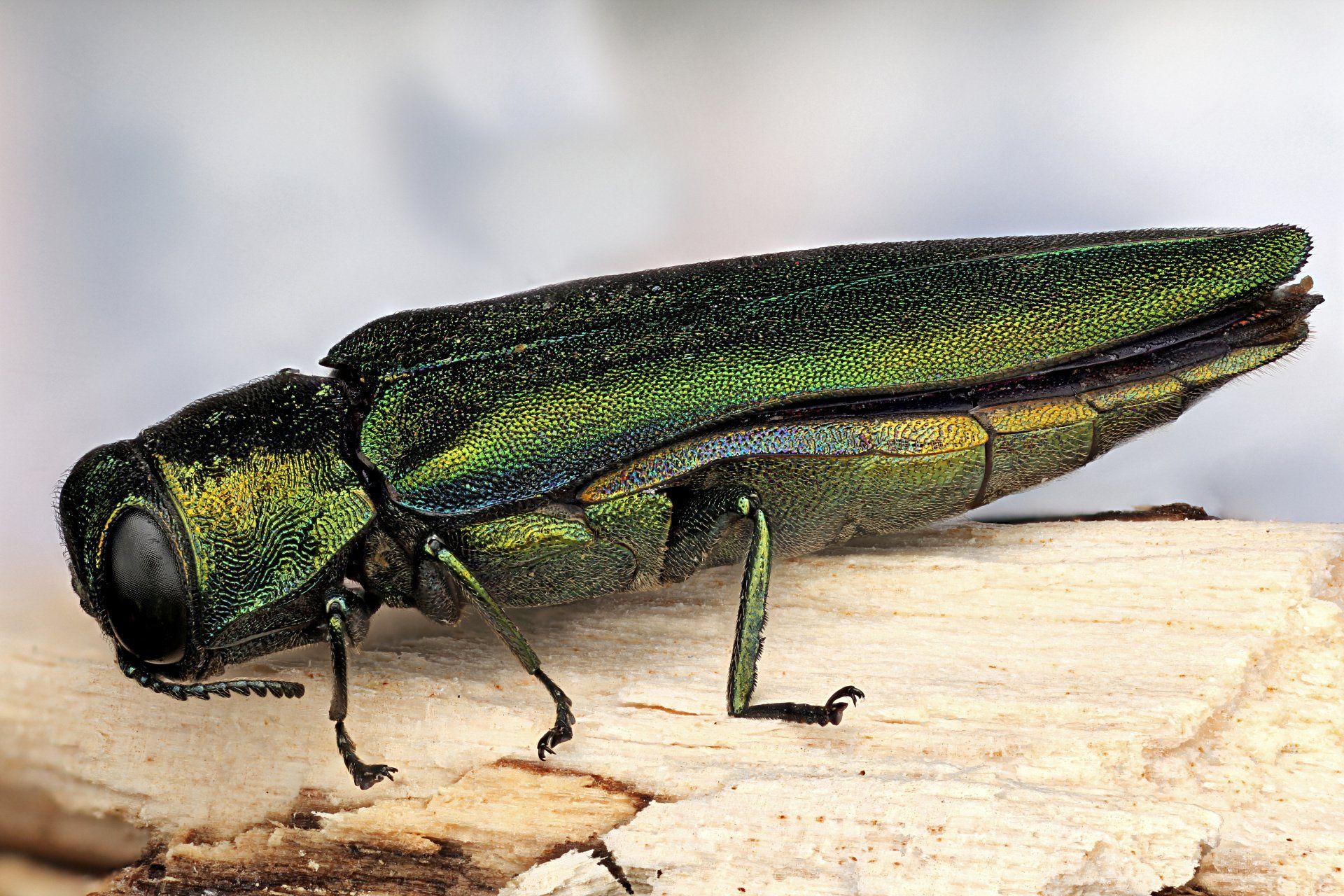
Emerald ash borer beetles are a species of jewel beetle that are named after their coloration and their diet of ash trees. They can grow between 26 – 32 mm long. These beetles are an extremely invasive species and is capable of devastating forests in a short time. With no real predators, these wood boring beetles attack ash trees and cause healthy trees to eventually die off. While the adults are responsible for some of the damage, most of the damage is done by the larvae. The eggs are laid under the bark and when they hatch, the larvae burrow into the tree to feed on the outer layer of skin. This severs the trees vascular system which causes the tree to die in short time.
Long Horned Beetles
There are approximately 900 different species of long horned beetles found in the US and Canada which range in size from 2 mm – 6 cm long. They have extremely long antennae which is how they earned their name. They come in a variety of colors and are common forest pests that can cause extensive damages to trees that are struggling. Their larvae are wood borers, similar to termites, and they are responsible for the destruction of thousands of dying trees when there is a long horn beetle infestation somewhere out in the wilderness. These types of infestations can lead to an abundance of dead trees which can also impact the likelihood of forest fires. Since the larvae can also lay dormant inside wood, they can be accidentally transported to new locations in wooden pallets or crates to create new infestations where long horn beetles didn’t previously exist.
Sawyer Beetles
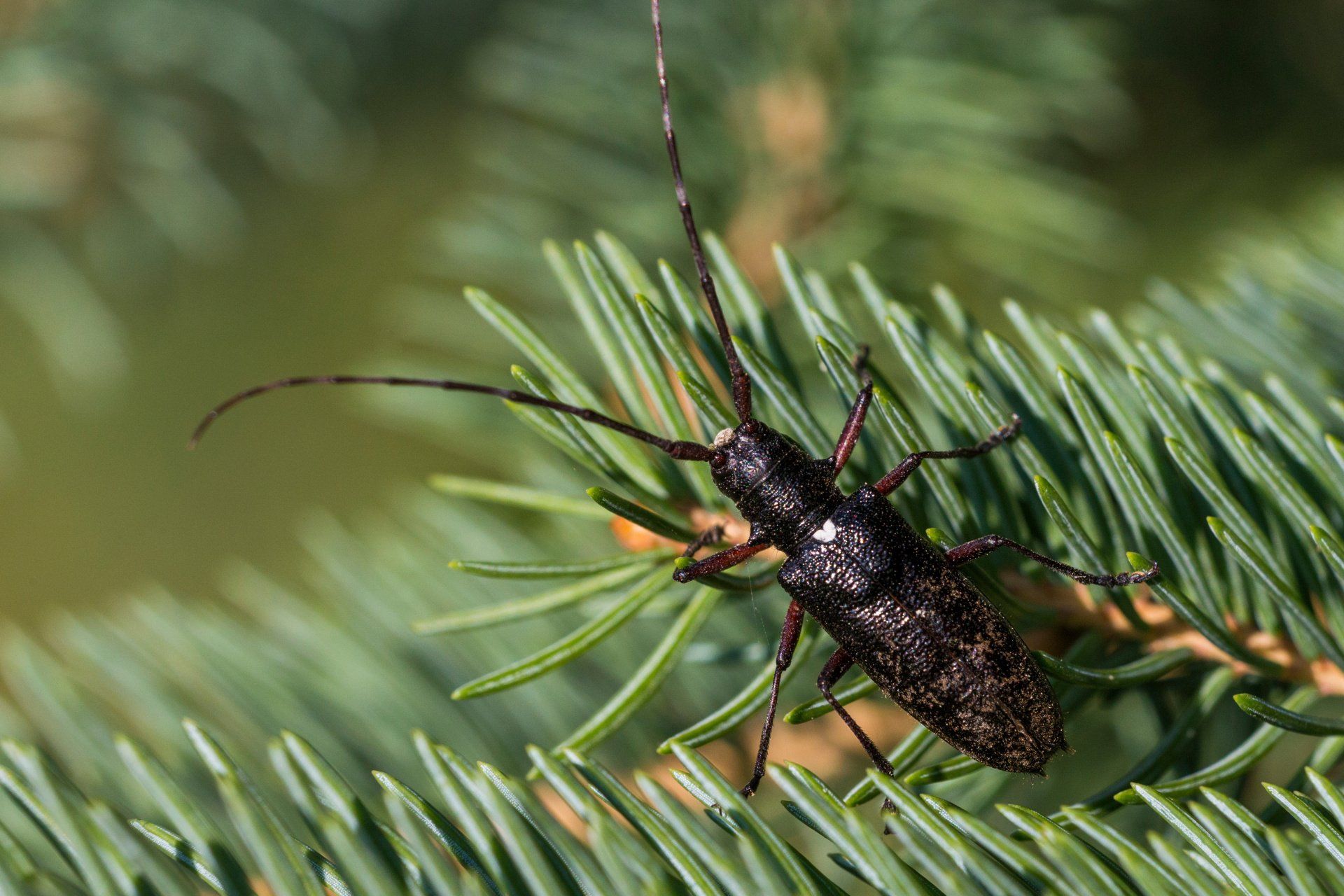
Sawyer beetles are longhorn beetles who feed on pines and other coniferous trees. They are hard to find because their coloration helps them blend in, but they are about 40 - 65 mm long and have long antennae. They are commonly found in densely forested areas and their larvae are wood boring organisms that feed on dead and decaying trees. These damaging pests can cause extensive tree loss as well as damage timber and make it unusable for commercial use.
Carrion Beetles

Carrion beetles are also known as burying beetles because they are known to dig into the skin of dead animals where it will consume the flesh and then lay eggs. These beetles tend to be between 9 – 30 mm and also have wings that they use to reach their next meal. They are common in North America with over 20 different species.
Rove Beetles

Rove beetles are a common beetle species and belong to a family with over 63,000 species globally with 4,100 species living in North America. They can come in sizes from 1 – 35 mm while the most common species are typically between 2 – 7.5 mm. They range in colors from red, brown, black, blue, green, and yellow. Rove beetles have a unique appearance with shortened wing covers and elongated bodies with 6 – 7 abdominal segments. These beetles are found in humid environments making them more common in the southeastern United States and especially around lakes, rivers, and ponds. Their diet consists of plants, insects, fungi, and decaying organic matter like feces and carrion.
Scarlet Lily Beetle
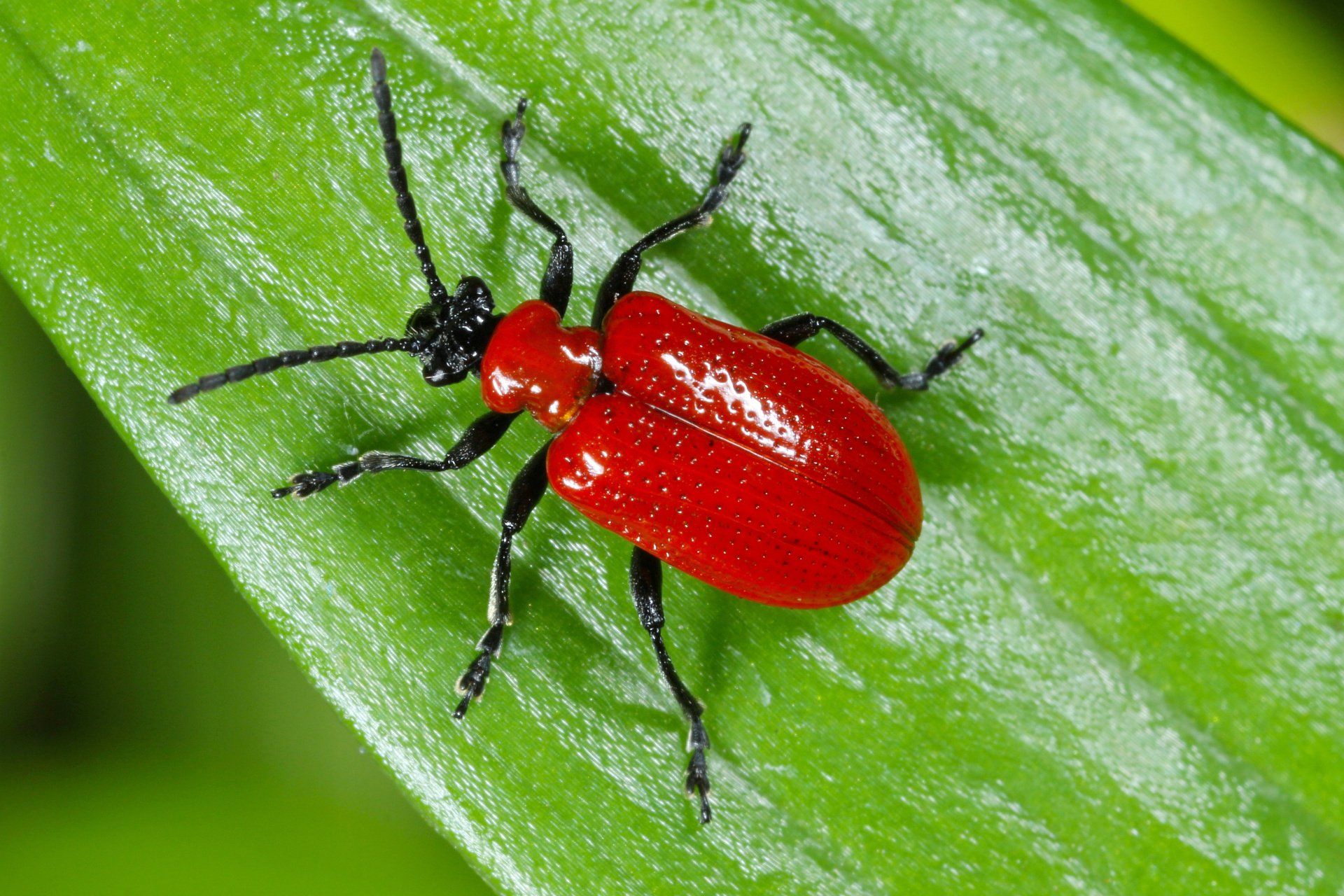
As their name implies, scarlet lily beetles prefer to feed on the leaves of lily flowers. The most common sign of these pests is lily plants with destroyed leaves and wilted flowers. They are smaller beetles that come in at 6 - 8 mm and have bright red wings and black legs and antennae. Unlike ladybugs, they do not have any distinct markings on their shell other than a tiny black triangle where their thorax appears from under their wings.
Drugstore Beetle
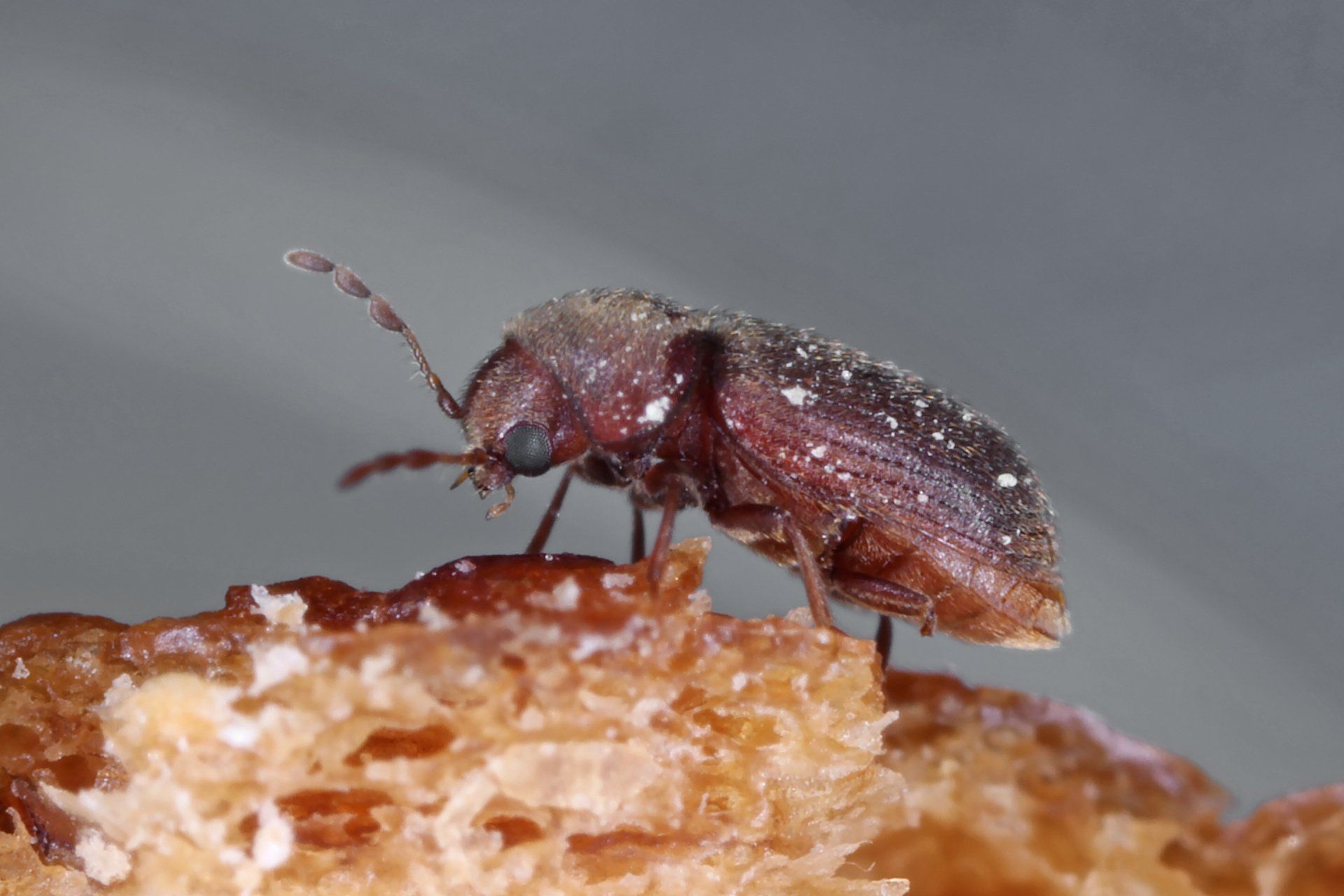
Drugstore beetles are very small flying brown beetles that measure between 2.25 – 3.5 mm long and have a cylindrical body that is covered in small hairs. They are also commonly called biscuit beetles or bread beetles because they feed on stored dried goods like grains, cereals, and bread. They are also known to eat paper, leather, spices, and seeds.
Stag Beetles
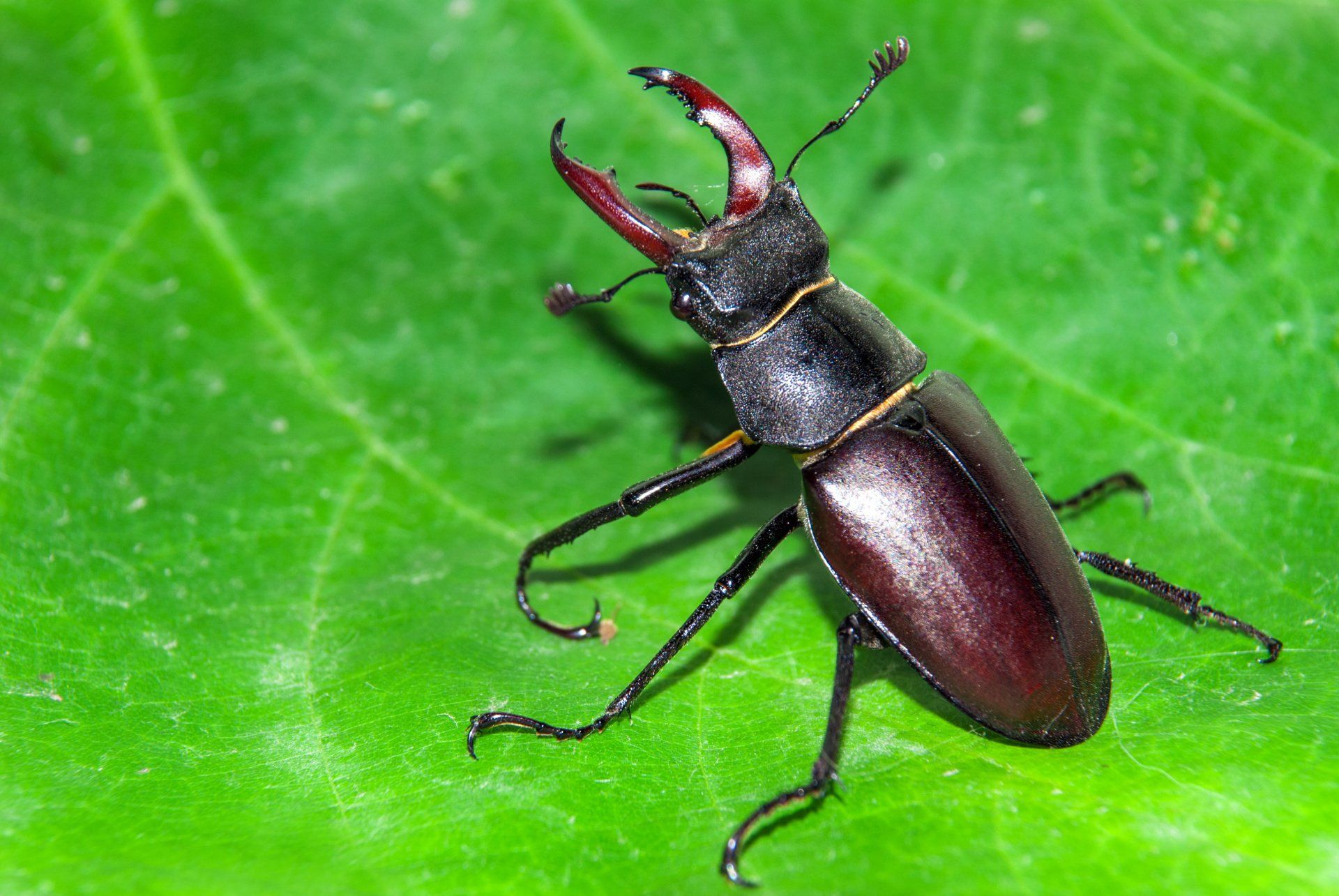
Stag beetles are most commonly identified by their large pincers which look like the horns of a stag deer. They are typically on the larger size, measuring in at 5 – 12 cm and are usually a brown or black color. There are roughly 1,200 species of stag beetles which feed on the sap of nearby plants or small soft bodied insects found in their habitats. Even though they are generally gentle creatures, stag beetles will use their large jaws to defend themselves against threats and competition when it comes time to mate.
Soldier Beetles
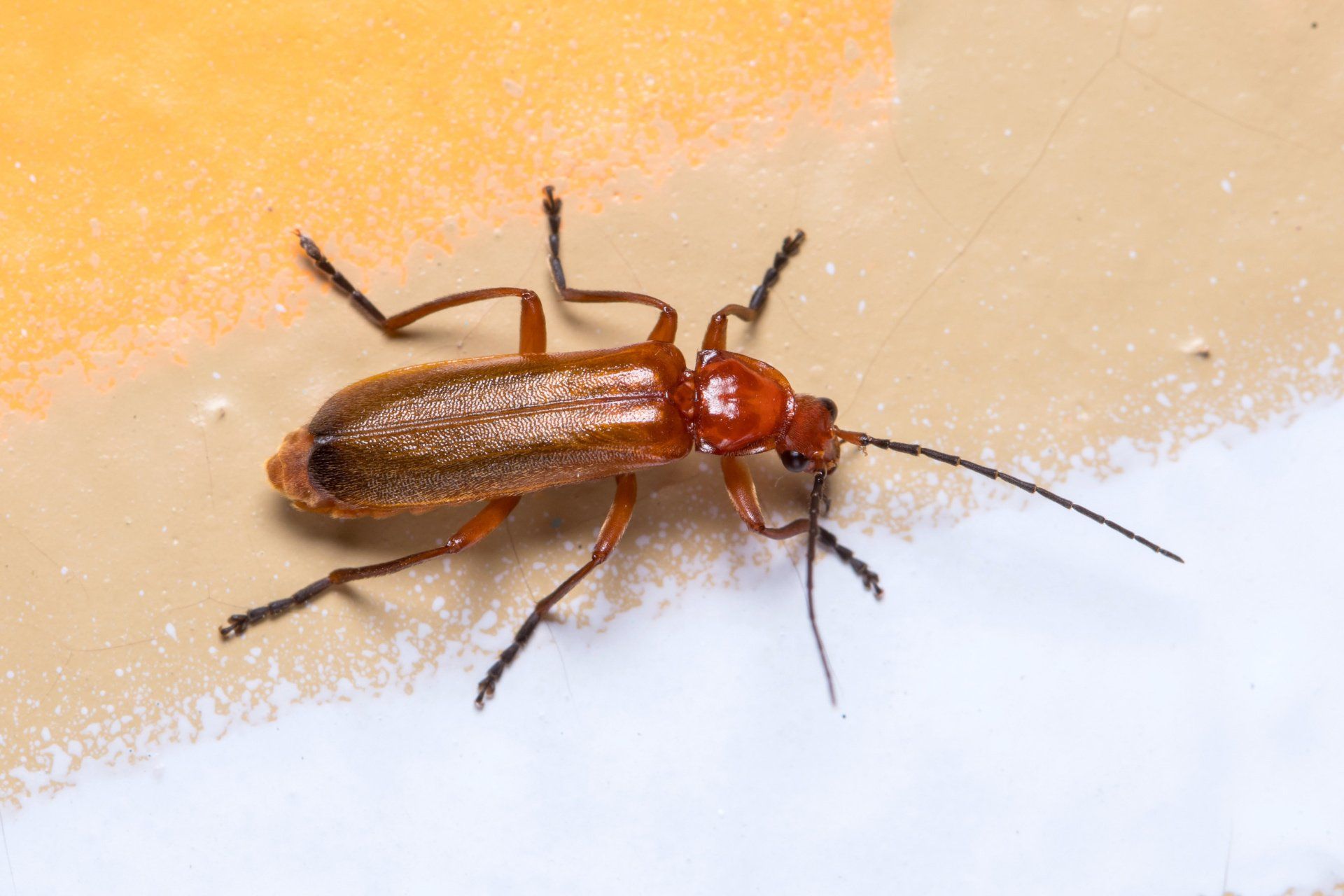
Soldier beetles are also called leatherwings because the most common species are identified by elongated, soft, red wings that they use to fly to find food. They are beneficial insects that feed primarily on pollen, nectar, and other plant destroying insects like aphids and caterpillars. There are over 35,000 species of soldier beetles found around the world that may range from yellow to brown and black and measure between 1.5 - 28 mm long. These beetles are slow fliers, so they have developed to secrete a toxic chemical called cantharidin that they release from pores along their body as a defense mechanism.
Blister Beetles
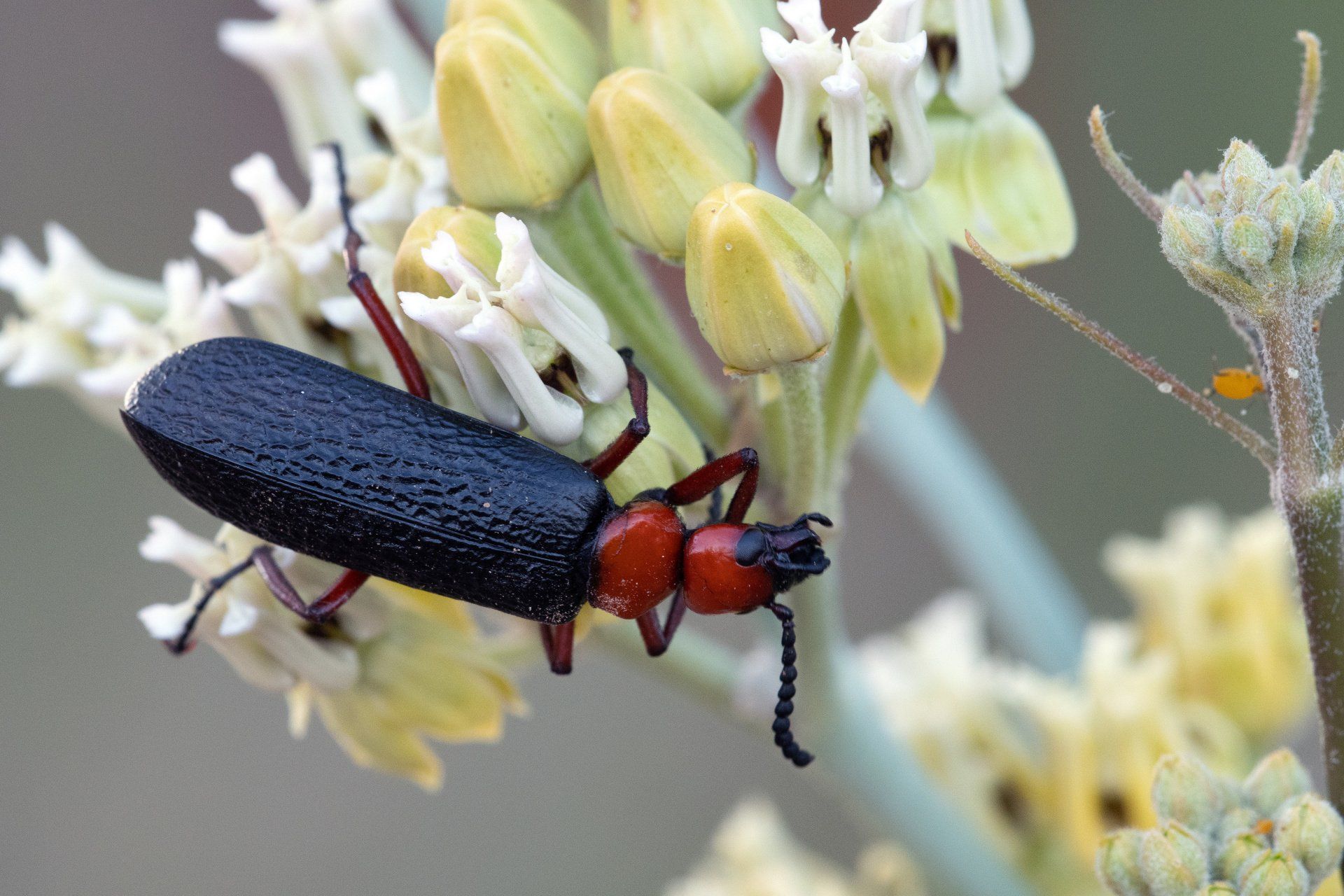
Blister beetles are related to soldier beetles and are capable of excreting the same toxic chemical, cantharidin. The reason they are called blister beetles, is because their excretion has been known to cause blistering on human skin. This same reaction is what also deters birds and lizards from eating them. There are over 7,500 species of blister beetles that exist around the world, and they are typically identified by their leathery wings and dark coloration. They can reach sizes of 2.5 cm long and they are voracious omnivores who feed on plants and other insects.
Fireflies
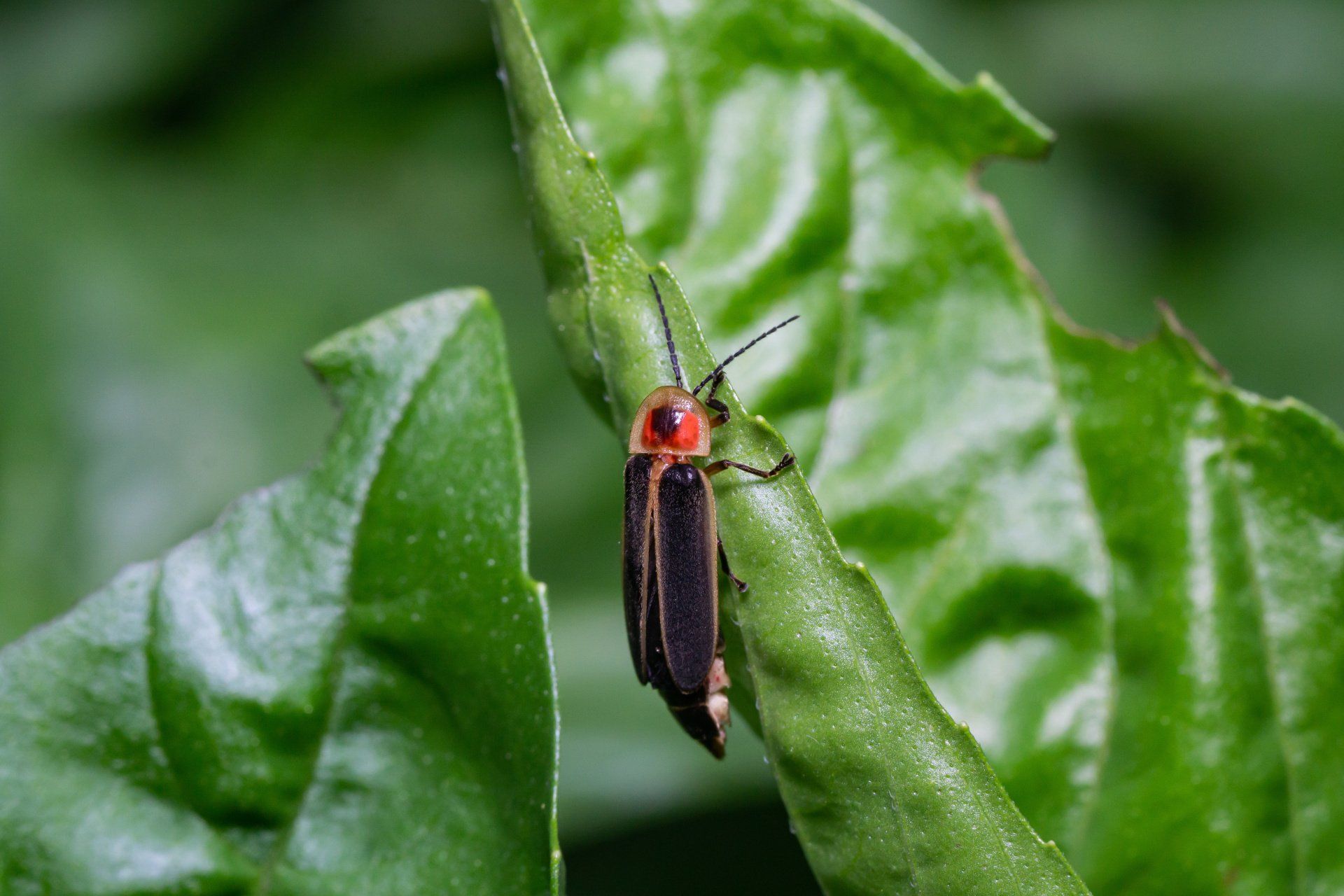
Fireflies are beetles that are identified by their unique ability to illuminate their bodies for short periods. They grow to be about 2.5 cm long and their bodies produce a chemical reaction that results in a bioluminescent flash. There are over 2,000 species that exist that live in various habitats around the world. They are nocturnal insects that use their flashing bodies to communicate with mates, lure in potential meals, and deter predators. Fireflies diet normally consist of small soft bodied insects, other fireflies, and nectar or pollen.
Click Beetles
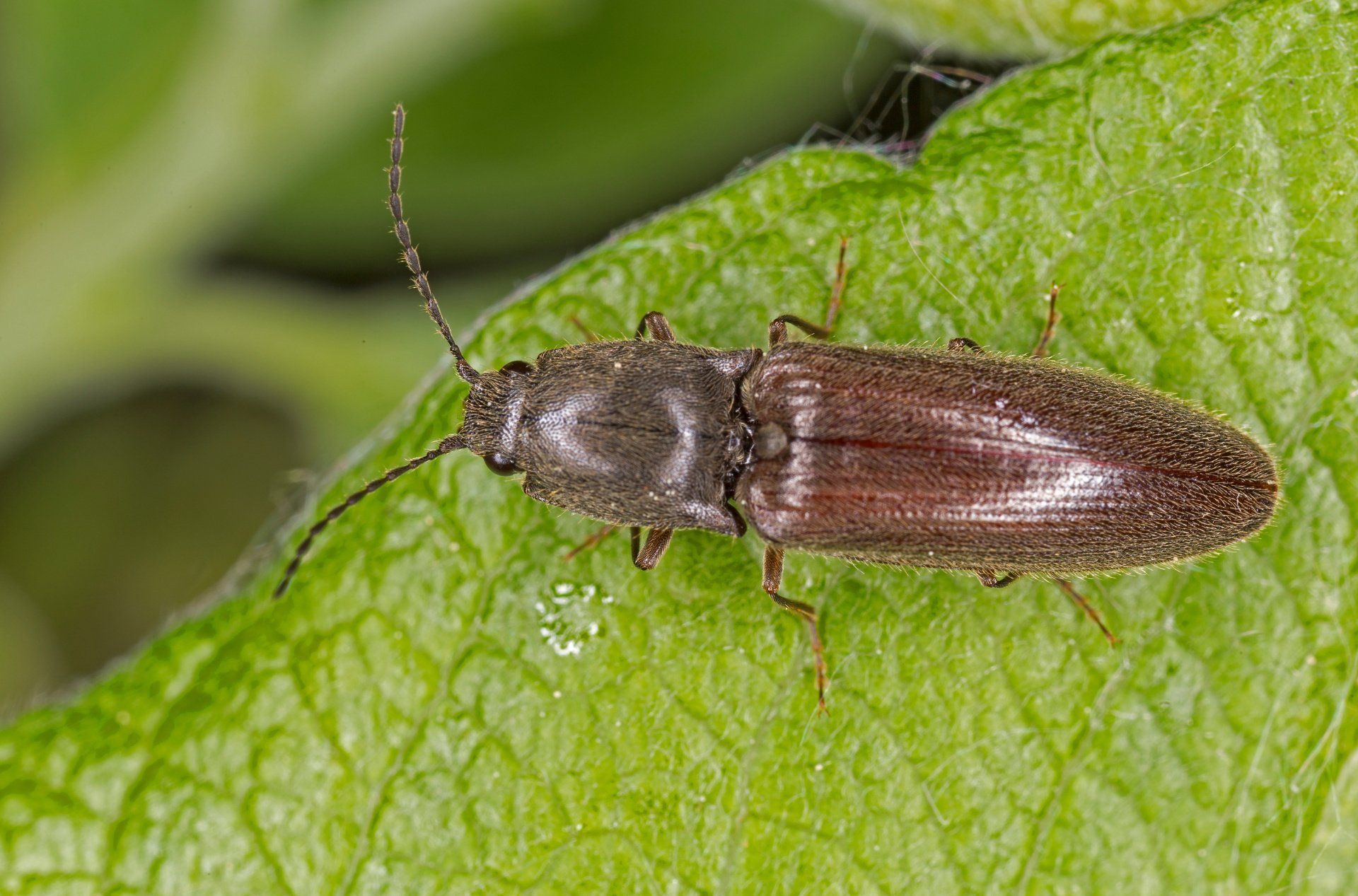
Click beetles make up less than 1,000 different species and often go by other names like skipjacks, elaters, and snapping beetles. They are identified by the loud clicking noise they emit when they jump around to escape predators or move to a new feeding ground. Their legs act as springboards, similar to fleas, which allow them to jump up to a foot in the air. The mechanism on their body that unleashes when the beetle jump is what makes the audible click sound. They are typically around 2 – 3 cm long with most species having elongated brown or black bodies. They sometimes have large eye looking markings on their backs to acts as markings to deter predators. They are typically nocturnal where they feed on plant life in the dark. These beetles cause enough damage that they are classified as destructive pests.
Whirligig Beetles
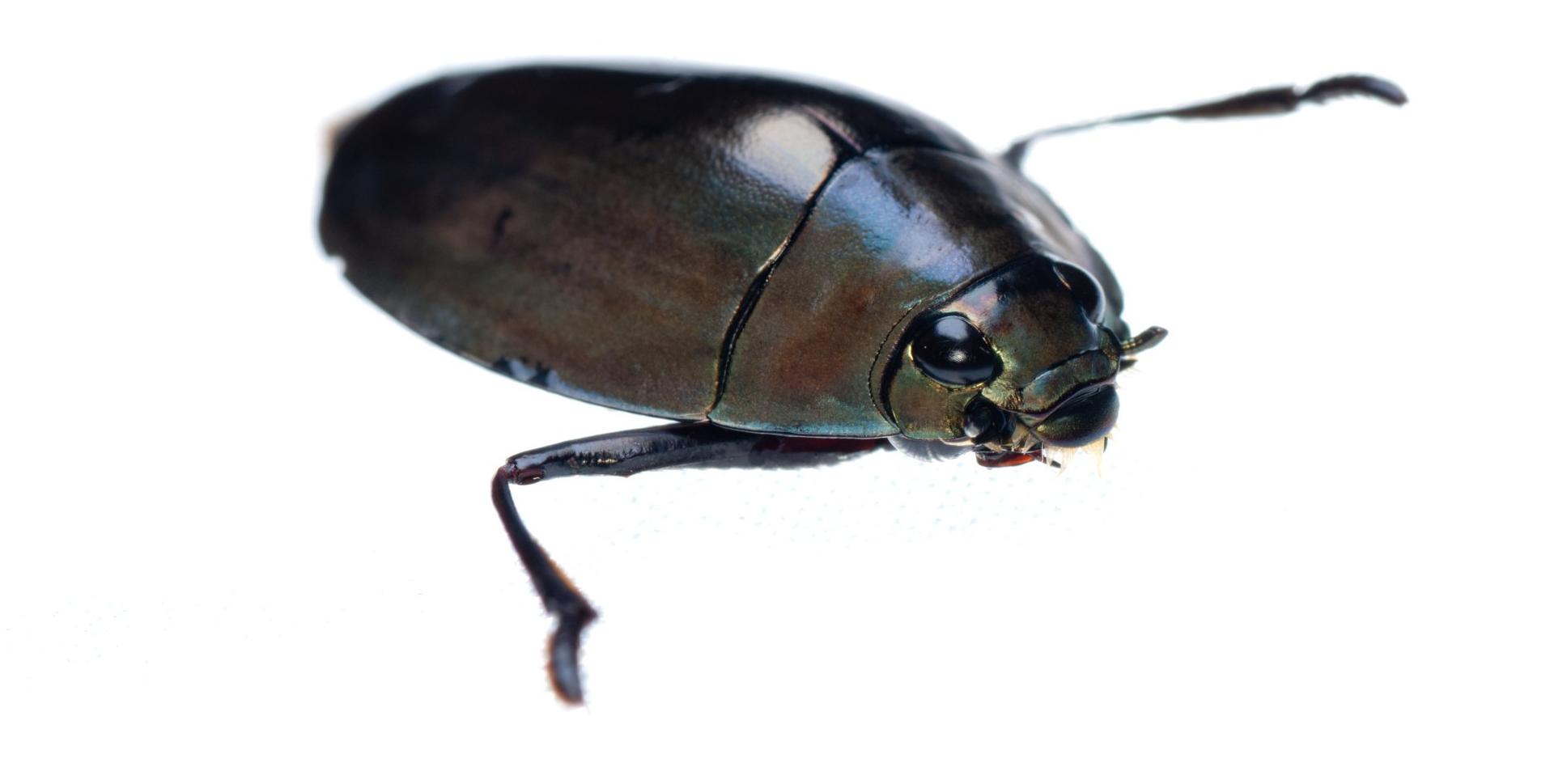
Whirligig beetles are one of the few beetles that spend most of their time living in water. They are known as whirligigs because they swim in circles when threatened which actually increases the likelihood of drawing the attention of fish that may be nearby while also making them harder to catch. There are over 700 species, and they are identified with an oval dark body with clubbed antennae and can reach 18mm in length. These beetles feed on other insects and sometimes even small fish that get too close.
Contact Professionals if You Have a Beetle Problem
If you are dealing with beetles and they are becoming bothersome or damaging, it is time to call professionals in to help implement control and prevention strategies. The team at EcoGuard Pest Management has the training and experience that can help ensure that your beetle problem is addressed so common household beetles like those found in your closets and pantries are dealt with quickly and effectively. Call today to schedule an appointment with one of our beetle control experts!


